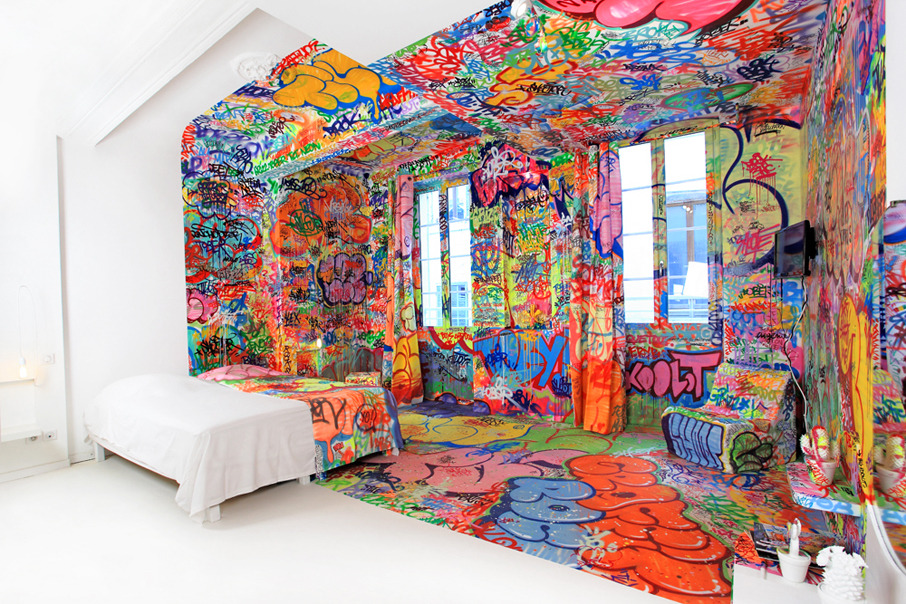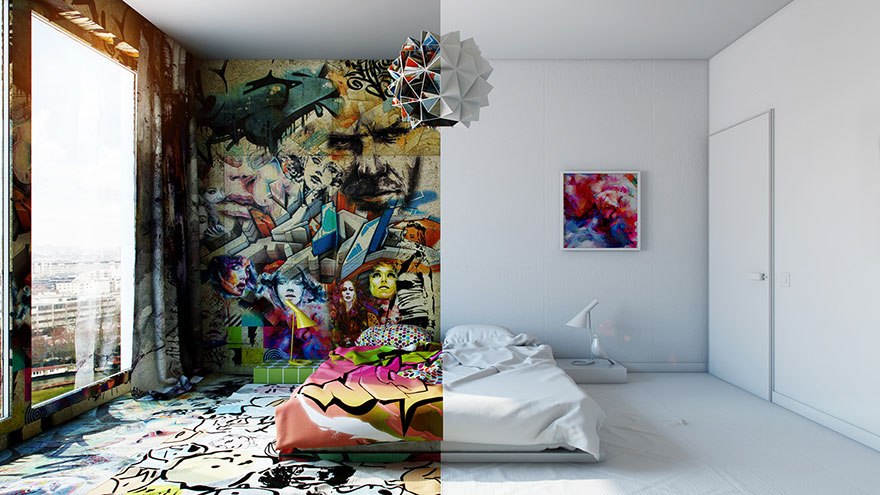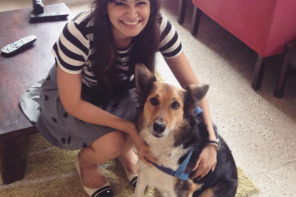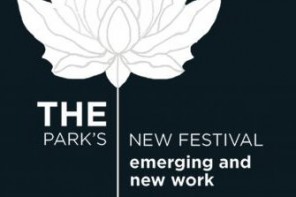Order and chaos are universally-acknowledged opposites but what if we told you that there are people who combine these elements in one single piece of art? Artists all over the world are coming up with creations that play with contrasting elements, and they are a sight to behold. We’ve heard that there are two sides to every coin but who would have thought this adage applied to works of art too? We looked around and found these seven artists who take contrast in art to a new level.
1. A DIFFERENT KIND OF SUNDAY BY PAVEL VETROV
It was Ukranian artist Pavel Vetrov’s work that first drew us to dichotomous art. Vetrov’s creation ‘Sunday‘ is a hotel room divided in two parts. One looks like it’s inhabited by a street artist who used the walls of his room as a practice zone while the other half looks like it’s straight out of a futuristic movie with its cold,pristine and pure white décor.
The room is a striking blend of minimalist and maximalist design since each side gives off a different vibe. The textures and colours of street art pop beautifully in the graffiti side while in contrast, the almost-colourless look of the minimalist side gives you space to breathe and relax. While we’re mesmerised by the vibrant colours on the left, we also like the soothing effect of the right half of the room. Which side would you prefer?
PHOTO COURTESY – Pavel Vetrov
2. PANIC AT THE HOTEL BY TILT
On his Behance page, Pavel Vetrov elucidates that his creation was inspired by French artist Tilt’s Panic Room. One look at Tilt’s work and we knew why. Panic Room is another hotel room which has a breath-taking feel akin to Sunday. The artist has created two sections in the same room which are in striking contrast with each other. Wild, uninhibited graffiti covers one side and the other is left pristine and untouched to give off an almost clinical vibe.
Tilt explains that he thought of the room as a huge canvas where he needed to think about the composition. He used the white part of the room to accentuate the chaos on the other side. As stunning as the finished room is, it is even more fascinating to watch Tilt and his co-creators working from start to end in this behind-the-scenes video.
PHOTO COURTESY- The Big Addict
3. STEPHANE JASPERT OFFERS A STONE FOR SORE EYES
Street artists, it appears, are skilled in playing with contrast as we can see from rock artist Stephane Jaspert’s work which can be seen in and around the walkways of Paris. He removes loose cobblestones from the streets and replaces them with rocks that he delicately paints with images and symbols from popular culture. Jaspert’s work becomes indelibly intriguing when we think about the dichotomy of his vibrant paintings, vulnerable to being washed off by raindrops or footfall, set against strong, ancient stones which exude permanence.
PHOTO COURTESY – Stephane Jaspert
4. THE REFLECTION OF NATURE BY DANIEL KUKLA
An easel, a mirror and an inspired photographer are all it takes to produce ‘Edge Effect‘, a series which consists of image-within-an-image photos highlighting the contrasting environmental elements found in ecosystems. In ecological sciences, the ‘Edge Effect’ is defined as the influence exerted by neighbouring ecosystems on one another. Photographer Daniel Kukla placed a mirror on an easel (yes, that’s a square mirror in the pictures below) and captured one terrain in the background with a neighbouring biome reflected in the mirror placed in the foreground.
The clever use of a mirror brings together two different ecosystems in one single frame. Clicked in Joshua Tree National Park, California, Kukla’s photos capture opposing elements found in the unique confluences of terrains.
PHOTO COURTESY – Daniel Kukla
5. SOPHIE GAMAND’S BLOSSOMING OF BARKS
If you’re a fan of dogs (50 cool points to your house), you’re going to love ‘Flower Power’ by photographer Sophie Gamand. This photo series seeks to reform common prejudices against pit bulls and paint them in a fairy-like, dreamy light. Pit bulls are often considered violent ‘bullies’ of the dog world due to the harsh imagery associated with them.
Sophie Gamand uses adorable models from three New York City dog shelters and photographs them with floral halos, featured in soft light which is in stark contrast to the usual gritty urban environments they are usually portrayed in to make them appear tough. Her rendering of this angelic version of pit bulls has a subtle dichotomy that shines through and melts our hearts.
PHOTO COURTESY – Sophie Gamand
6. SEVERIJA CROSS (STITCHES) MY HEART
Lithuanian artist Severija Incirauskaite-Kriauneviciene takes contrast to new heights by doing cross-stitch embroidery on metal objects. The visual of soft, colourful embroidery stitched onto rusty tin cans, shovels, plates and other things is beautiful in its duality.
While the embroidery serves its purpose in enhancing the look of the metallic base, an interesting twist is observed in the artist’s work—the sheer dullness of the metal objects makes the cross-stitched pattern appear even more vibrant and focuses the viewer’s attention on it. This is definitely a fascinating juxtaposition of the ornate and tarnished.
PHOTO COURTESY – Laughing Squid
7. TO NEW YORK, WITH LOVE FROM WILL RYMAN
Will Ryman takes the concept of flowers blooming through concrete and presents it in a 25-feet-high version, complete with scattered rose petals. His public art installation ‘The Roses‘, which sprung up in New York City in 2011, consisted of 38 sculptures of rose blossoms, spread along Park Avenue.
Set against the bleak, wintry background of the concrete jungle that is New York City, the sculptures of rose blooms—in vibrant pink and red hues—were considered Will Ryman’s large-scale love letter to the city. It is interesting to see the flowers, a symbol of nature and life, spring forth from the ground amidst grey buildings of the city. It invokes an oddly sentimental feeling of victory against all odds.
PHOTO COURTESY – Paul Kasmin Gallery
We’re awe-struck by the wonderful ways in which artists have combined dissimilar elements in their works. What captivated us even more was the message hidden behind each piece—of harmony and concord between the most opposite of components—that stays with you long after you’ve stopped looking at it. Perhaps there is a lesson to be learnt here. Dichotomy isn’t always undesirable, sometimes it can be the most beautiful thing if only you look at it with the right vision.

























